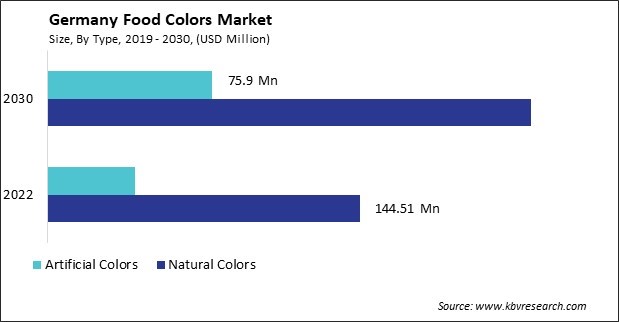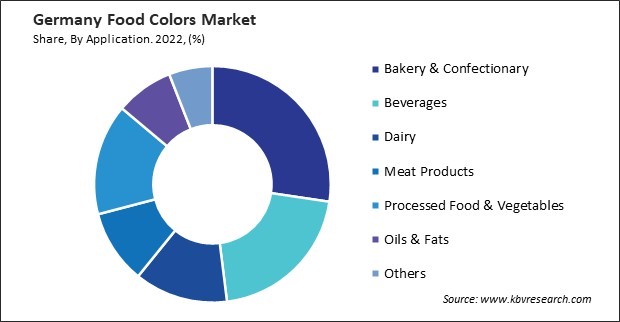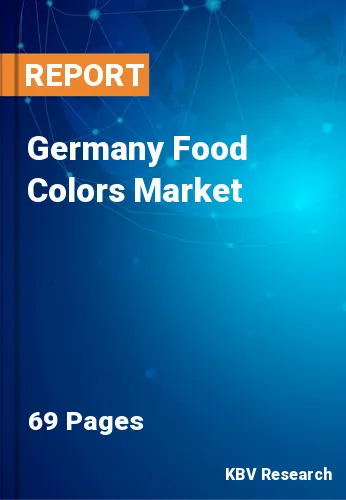The Germany Food Colors Market size is expected to reach $299.64 million by 2030, rising at a market growth of 6.3% CAGR during the forecast period. In the year 2022, the market attained a volume of 979.26 Tonnes units, experiencing a growth of 6.5% (2019-2022).
The food colors market in Germany reflects the country's rich culinary traditions and diverse consumer preferences. The demand for natural and organic food colors has witnessed a notable surge in Germany, driven by an increasing awareness of health and wellness among consumers. Germans are increasingly conscious of the impact of artificial additives on their well-being, prompting a shift towards products that use natural sources for coloration. This trend has propelled the plant-based and fruit-derived food colors market as consumers seek cleaner and more transparent labels.

The COVID-19 pandemic has left an indelible mark on the food and beverage industry, including the food color market in Germany. One significant outcome of the pandemic is the heightened awareness of health and immunity among German consumers. Moreover, Germany's thriving vegan and vegetarian movements have influenced the food colors market. Plant-based and cruelty-free alternatives are gaining popularity, aligning with the country's environmentally conscious ethos. Manufacturers are responding to this demand by offering various plant-based food coloring options, contributing to the overall industry growth.
In the dynamic landscape of the German food and beverage industry, the preferences of manufacturers in selecting synthetic colors play a pivotal role in shaping product aesthetics and consumer appeal. Food colors are a common practice to enhance the visual appeal of products, influencing consumer perceptions and preferences.
German food and beverage manufacturers often prioritize synthetic colors due to their versatility and stability. These colors are synthetically produced and offer a wide spectrum of vibrant and consistent hues, providing manufacturers with precise control over the final appearance of their products. This control is crucial in ensuring that food and beverage items meet aesthetic and branding standards, aligning with the meticulous attention to quality that German consumers expect.
Moreover, synthetic colors have gained favor among manufacturers for their ability to withstand variations in processing conditions and shelf life, ensuring that the visual appeal of products remains intact throughout the supply chain. This is crucial in an industry where consumers associate vibrant and appealing colors with freshness and quality. Furthermore, the trend towards natural and clean-label products in Germany has influenced the selection of synthetic colors that mimic natural shades.
According to Germany Trade & Invest, Germany's food and beverage industry is the fourth-largest sector in the country, contributing a substantial production value of EUR 185.3 billion in 2020. The total revenue from food retailing experienced noteworthy growth, surging 8.2 percent to reach EUR 227 billion in the same year. The industry's distribution channels encompass various avenues, with exported processed foods amounting to EUR 61.6 billion and food service sales totaling EUR 53.6 billion.
In this dynamic landscape, it is noteworthy that food and beverage manufacturers in Germany are particularly inclined towards synthetic colors, reflecting a trend in the food colors market. Therefore, manufacturers' strategic preference for synthetic colors in the dynamic German food and beverage industry underscores their commitment to precision, stability, and meeting consumer expectations for visually enticing products.
In Germany, the demand for convenience foods and ready-to-eat products has witnessed a significant upsurge, shaping the dynamics of the food colors market. This shift in consumer behavior are attributed to various factors, reflecting the evolving lifestyle and preferences of the German population. One key driver of this trend is modern Germans' fast-paced and busy lifestyles. With increasing work pressures and time constraints, there is a growing inclination towards quick and convenient meal solutions. Ready-to-eat products and convenience foods offer a time-efficient alternative for individuals seeking hassle-free meal options without compromising taste or nutrition.
Moreover, changing demographics, including an increase in single-person households and dual-income families, have increased demand for on-the-go and easily prepared meals. The influence of urbanization and the prevalence of Westernized eating habits have also shaped consumer preferences. Urban centers in Germany often feature a fast-paced lifestyle, leading to a higher reliance on pre-packaged, ready-to-eat options. This has further fueled the demand for food colors in manufacturing these products as manufacturers seek to enhance the visual appeal of their offerings to attract consumers.
In Germany's food color market, manufacturers are also responding to the growing awareness and preference for natural and organic ingredients. Consumers are increasingly looking for products that not only offer convenience but also align with their health and wellness goals. As a result, the market has witnessed a rise in the demand for natural food colors derived from plant-based sources. Hence, the surge in demand for convenience foods in Germany, driven by busy lifestyles and changing demographics, has significantly influenced the food colors market.

The food colors market in Germany is a dynamic and innovative sector driven by the country's strong culinary traditions, evolving consumer preferences, and the demand for high-quality and natural ingredients. One of the key players in the German food colors market is the ROHA Group. With a significant presence globally, ROHA is recognized for its diverse range of synthetic and natural food colors. The company has established a strong foothold in Germany, catering to various applications in the food industry, from confectionery and bakery products to beverages. ROHA's commitment to product quality, safety, and compliance with German regulations positions it as a reliable partner for food manufacturers in the country.
Chr. Hansen, a Danish company with a strong presence in Germany, specializes in natural food colors solutions. It is leveraging its expertise in fermentation and biotechnology, Chr. Hansen provides a range of colors options derived from fruits, vegetables, and other natural sources. The company's commitment to sustainable practices and understanding of German consumers' increasing focus on health and wellness contribute to its prominence in the German food colors segment.
DSM Nutritional Products, a global science-based company, is actively engaged in providing food colors solutions in Germany. DSM's portfolio includes a variety of colorants catering to the diverse needs of the German food industry. The company's emphasis on research and development, coupled with its commitment to meeting regulatory standards, positions DSM as a significant player in the German food colors market.
Naturex, a part of the Givaudan group, is known for its natural ingredient solutions, including food colors. In Germany, Naturex focuses on delivering clean-label alternatives derived from botanical sources. The company's commitment to transparency and alignment with German consumers' preferences for natural and authentic products make it a noteworthy contributor to the food colors market in the country. These companies operate in a competitive market where factors such as innovation, sustainability, and adherence to regulatory standards play crucial roles.
By Type
By Application
Our team of dedicated experts can provide you with attractive expansion opportunities for your business.

